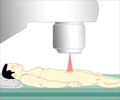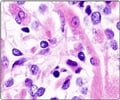A new radiotherapy system that combines high-tech imaging with precision tumour-targeting capability is proving to be very beneficial for the patients.
Cancer specialists at Stony Brook University Medical Center say that a new radiotherapy system that combines high-tech imaging with precision tumour-targeting capability is proving to be very beneficial for the patients.
The doctors say that people with medically inoperable tumours or the ones who do not want surgical treatment may benefit most from the ExacTrac X-ray 6D System for image-guided radiotherapy.They have revealed that the system adds to patient options for stereotactic body radiation therapy (SBRT), a technique that features high radiation doses with pinpoint precision to tumours.
This procedure is the least invasive method available to treat his disease.
“Other than mild redness, I experienced no side effects from the treatment and feel very good,” says Denis Keefe, a 63-year-old lung cancer patient, whose tumour has shrunk since the treatment.
“I was comfortable during the procedure and only needed to go for three treatment sessions,” he added.
The power and precision of the system also allows for short therapeutic duration. Treatments take one-to-two weeks to complete and require only three or four doses, compared to conventional beam therapy that often lasts many weeks and many doses.
Advertisement
“ExacTrac enables us to deliver treatment to some previously irradiated sites without damaging critical structures like the spinal cord. This greatly improves our ability to treat some inoperable tumours and cancers that spread from primary sites,” Dr. Meek added.
Advertisement
Source-ANI
LIN/P











